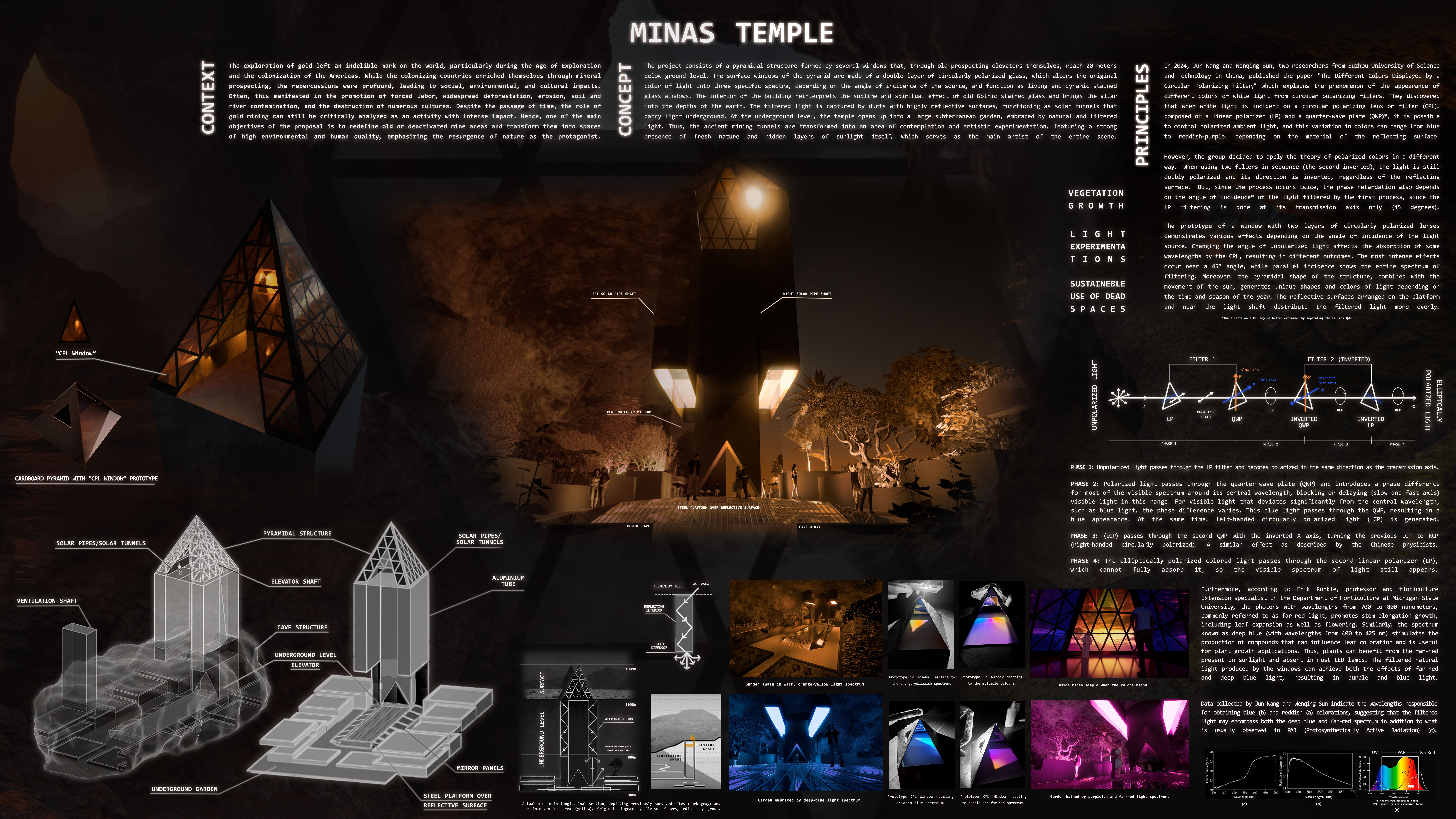2024 - MINAS TEMPLE

Category
Daylight Investigations - Region 3: The Americas
Students
Erich Franz Armond Hoppe
Teacher
Juliana Torres Miranda
School
Universidade Federal de Minas Gerais
Country
Brazil
Download
Download project board
The exploration of gold left an indelible mark on the world, particularly during the Age of Exploration and the colonization of the Americas. While the colonizing countries enriched themselves through mineral prospecting, the repercussions were profound, leading to social, environmental, and cultural impacts. Often, this manifested in the promotion of forced labor, widespread deforestation, erosion, soil and river contamination, and the destruction of numerous cultures. Despite the passage of time, the role of gold mining can still be critically analyzed as an activity with intense impact. Hence, one of the main objectives of the proposal is to redefine old or deactivated mine areas and transform them into spaces of high environmental and human quality, emphasizing the resurgence of nature as the protagonist. The project consists of a pyramidal structure formed by several windows that, through old prospecting elevators themselves, reach 20 meters below ground level. The surface windows of the pyramid are made of a double layer of circularly polarized glass, which alters the original color of light into three specific spectra, depending on the angle of incidence of the source, and function as living and dynamic stained glass windows. The interior of the building reinterprets the sublime and spiritual effect of old Gothic stained glass and brings the altar into the depths of the earth. The filtered light is captured by ducts with highly reflective surfaces, functioning as solar tunnels that carry light underground. At the underground level, the temple opens up into a large subterranean garden, embraced by natural and filtered light. Thus, the ancient mining tunnels are transformed into an area of contemplation and artistic experimentation, featuring a strong presence of fresh nature and hidden layers of sunlight itself, which serves as the main artist of the entire scene. In 2024, Jun Wang and Wenqing Sun, two researchers from Suzhou University of Science and Technology in China, published the paper “The Different Colors Displayed by a Circular Polarizing Filter,” which explains the phenomenon of the appearance of different colors of white light from circular polarizing filters. They discovered that when white light is incident on a circular polarizing lens or filter (CPL), composed of a linear polarizer (LP) and a quarter-wave plate (QWP), it is possible to control polarized ambient light, and this variation in colors can range from blue to reddish-purple, depending on the material of the reflecting surface. However, the group decided to apply the theory of polarized colors in a different way. When using two filters in sequence (the second inverted), the light is still doubly polarized and its direction is inverted, regardless of the reflecting surface. But, since the process occurs twice, the phase retardation also depends on the angle of incidence of the light filtered by the first process, since the LP filtering is done at its transmission axis only (45 degrees). The prototype of a window with two layers of circularly polarized lenses demonstrates various effects depending on the angle of incidence of the light source. Changing the angle of unpolarized light affects the absorption of some wavelengths by the CPL, resulting in different outcomes. The most intense effects occur near a 45º angle, while parallel incidence shows the entire spectrum of filtering. Moreover, the pyramidal shape of the structure, combined with the movement of the sun, generates unique shapes and colors of light depending on the time and season of the year. The reflective surfaces arranged on the platform and near the light shaft distribute the filtered light more evenly. Furthermore, according to Erik Runkle, professor and floriculture specialist in the Department of Horticulture at Michigan State University, the photons with wavelengths from 700 to 800 nanometers, commonly referred to as far-red light, promotes stem elongation growth, including leaf expansion as well as flowering. Similarly, the spectrum known as deep blue (with wavelengths from 400 to 425 nm) stimulates the production of compounds that can influence leaf coloration and is useful for plant growth applications. Thus, plants can benefit from the far-red present in sunlight and absent in most LED lamps. The filtered natural light produced by the windows can achieve both the effects of far-red and deep blue light, resulting in purple and blue light. Data collected by Jun Wang and Wenqing Sun indicate the wavelengths responsible for obtaining blue and reddish colorations, suggesting that the filtered light may encompass both the deep blue and far-red spectrum in addition to what is usually observed in PAR (Photosynthetically Active Radiation).

























